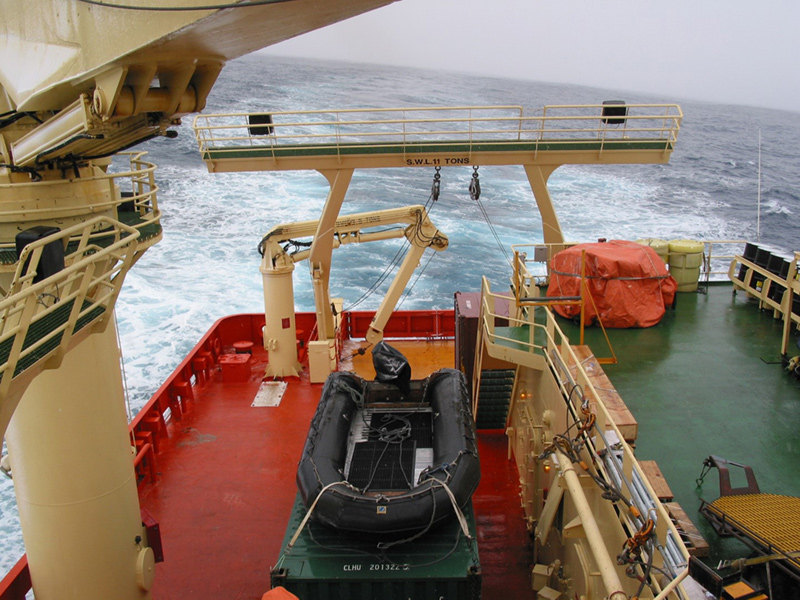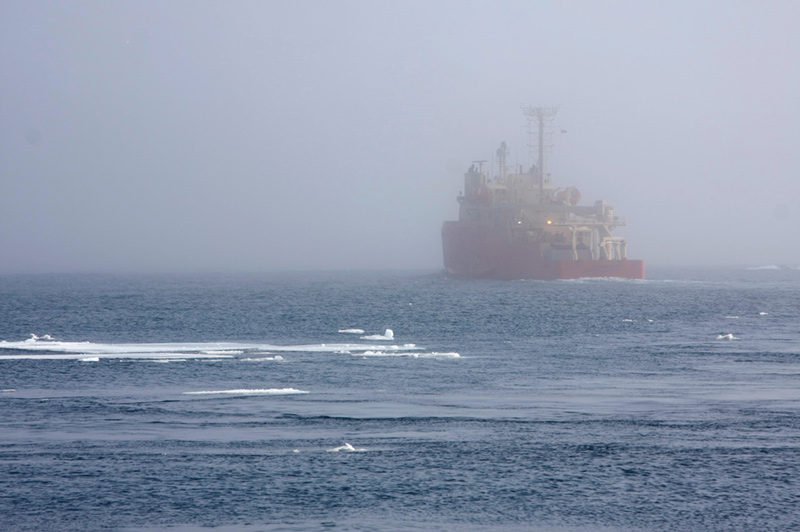The Southern Ocean's Carbon Sink Stronger than EverThe waters around Antarctica seem to have reversed a troubling trendPosted May 4, 2016
Bucking predictions, observations now show that the Southern Ocean is pulling more carbon dioxide out of the atmosphere than ever recorded, which could have implications for predicting the rate of climate change. Previous research had indicated that the Southern Ocean was pulling less carbon dioxide out of the atmosphere every year and might be growing saturated with the gas. However, according to two separate papers published in the journals Geophysical Research Letters “The ocean uptake of carbon dioxide in this region is growing over time,” said David Munro, a research associate at the Institute of Arctic and Alpine Research at the University of Colorado at Boulder and lead author of the GRL paper. Munro’s research uses nearly a million readings taken by instruments onboard the Antarctic research vessel Laurence M. Gould as it crisscrossed the Drake Passage between the southern tip of Chile and the Antarctic Peninsula from 2002 to 2015. The National Science Foundation (NSF) manages the Antarctic Program, which operates the research vessel. In addition, Munro’s research is supported by the NSF. 
Photo Credit: Kurtis Burmeister
The Laurence M. Gould crosses the Drake Passage about twenty times per year. Each time it does, it samples the carbon dioxide levels in the Southern Ocean.
“There are about 20 crossings [per year] across the Drake Passage which makes it the most densely -sampled region in the Southern Ocean since 2002,” Munro said. Though the Gould’s data only covers a relatively small section of the under-sampled Southern Ocean, it’s the most complete, continuous record of its carbon-dioxide levels. The paper in Science incorporated the data from the Gould, as well as other observations from different sources across the ocean to create a more expansive picture of the region. “We both actually came to the same conclusion with different methods,” said Peter Landschützer, a post-doc at the Swiss Federal Institute of Technology in Zurich and lead author of the Science paper. “We’re using interpolation methods so we can make a statement about the Southern Ocean as a whole.” Areas that absorb excess carbon dioxide, known as carbon sinks, help mitigate the greenhouse gas’s effect on climate change. The more carbon dioxide that gets pulled out of the atmosphere, the less there is to drive up the planet’s temperature. “The Southern Ocean is a really important regulator for the atmospheric carbon-dioxide concentration, and it helps to absorb a lot of the anthropogenic emissions of carbon dioxide [resulting from] the burning of fossil fuels,” said Nicole Lovenduski, an assistant professor at the Institute of Arctic and Alpine Research at the University of Colorado, Boulder and a co-author on the GRL paper. Of all the carbon dioxide released into the air in any given year, only about half stays in the atmosphere; the rest is absorbed by the plants and soil covering the Earth’s surface and its oceans. The Southern Ocean absorbs about 40 percent of the carbon dioxide taken in by the oceans, even though it only makes up about 25 percent of the planet’s marine surface area. 
Photo Credit: Jon Brack
The southern oceans is one of the most important carbon sinks on the planet.
The region absorbs so much carbon dioxide in part because of its frigid temperatures. Gases, including carbon dioxide, are more soluble in cold water than in warm water. In addition, gusty winds in the region churn the water more than elsewhere. “Strong winds are blowing over the Southern Ocean and that is upwelling water that hasn’t seen the atmosphere for hundreds and hundreds of years,” Lovenduski said. “That extra CO2 that we put into the atmosphere, it wasn’t there when that water sank hundreds of years ago. It has to re-equilibrate with the overlying atmosphere.” The Science paper confirmed past research that showed that the Southern Ocean was absorbing less carbon dioxide every year for much of the 1990s. However, additional observations showed that starting around 2002 this trend reversed and has since more than surpassed previously recorded levels, though the reasons for this rebound are still not entirely clear. “The carbon sink in the Southern Ocean is more variable than we originally thought,” Lovenduski said. “The idea that a sink could be growing then the sink could be shrinking, then the sink could be growing again over the different decades was quite surprising.” Though less carbon dioxide in the atmosphere might slow climate change somewhat, more in the oceans would likely have a negative impact on ocean life. “The uptake of carbon dioxide by the ocean is great for the atmosphere, but it’s not particularly good for the ocean in the sense that it makes the ocean more acidic,” Lovenduski said. “This acidification is not likely to be good for organisms living in the Southern Ocean. The Southern Ocean is in fact believed to be one of the more vulnerable places for acidification. 
Photo Credit: Deepak Adhikari
As the Southern Ocean absorbs more carbon dioxide, it could weaken the shells of ocean wildlife like this sea pteropod.
Acidified ocean waters can weaken the shells in some species of algae and shellfish, putting stress on the base of the marine food web. According to the Intergovernmental Panel on Climate Change, more than 200 billion tons of carbon cycle through the planet’s atmosphere, oceans and plants every year, with humans adding about 10 billion additional tons annually. Today, the Southern Ocean absorbs roughly 1.2 billion tons of carbon, roughly doubling its uptake from 2002. “It’s [an increase of] about 0.6 billion tons of carbon,” Landschützer said. “That sounds [like] a lot but if you put that in context, if you look at for example the global carbon budget, then you will find that this is actually a small fraction compared to the amount of CO2 that is emitted from humans.” This unexpected rebound in carbon-absorption rates complicates the picture of the Southern Ocean, and researchers say that it makes it more difficult to calculate what might happen in the coming decades. “We cannot predict the future with our data-based interpolation, but it certainly helps to understand the future, and to understand how the Southern Ocean as a carbon system works,” Landschützer said. NSF-funded research in this story: Nicole Lovenduski, University of Colorado at Boulder, Award No. 1155240 |
"News about the USAP, the Ice, and the People"



For USAP Participants |
For The Public |
For Researchers and EducatorsContact UsU.S. National Science FoundationOffice of Polar Programs Geosciences Directorate 2415 Eisenhower Avenue, Suite W7100 Alexandria, VA 22314 Sign up for the NSF Office of Polar Programs newsletter and events. Feedback Form |


